VLS Maxvert 2 Driver Review: Revolutionary & Senior-Friendly
Easier Launch? Better Accuracy? More Distance? Here’s What the Senior-Centered Maxvert 2 Can Do for You.
What if all it took to improve your launch, advance your accuracy, and add 20 yards to your drive was simply getting a new driver in your hands?
We know—that’s the fantasy all clubmakers sell.
But the new VLS Maxvert 2 driver delivers the same promise along with a pretty compelling suggestion:
What if it didn’t work with those other drivers because those drivers weren’t made for your swing?
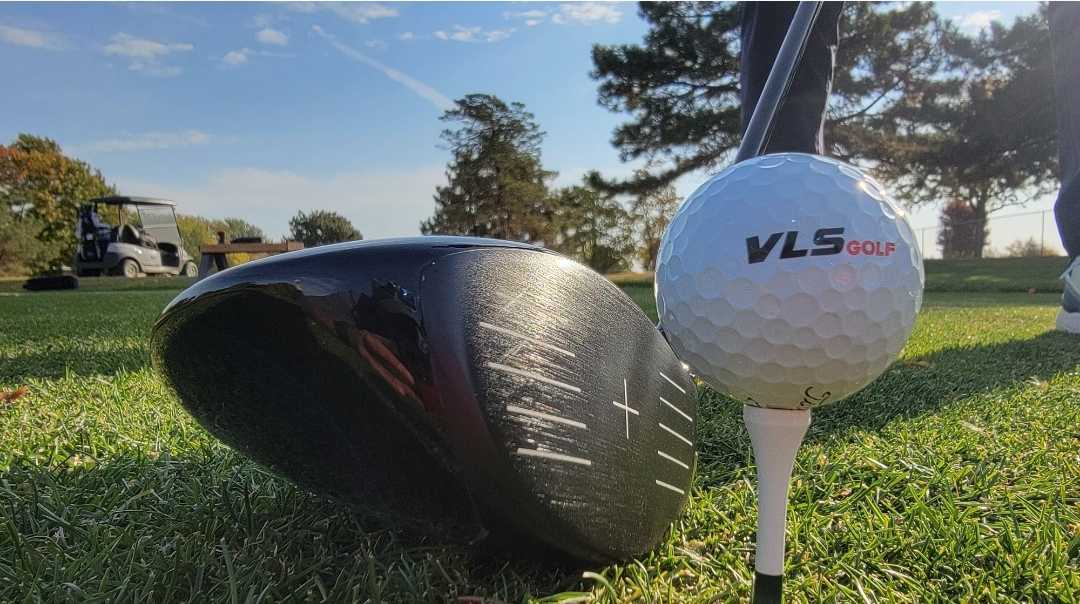
It’s no secret that all the big clubmakers seek the emphatic endorsements of the top professional golfers. So what if the very features that enhance a tour player’s performance actually wreak havoc on yours?
And what would it be like to swing a driver that wasn’t just made for the amateur golfer, but for the senior amateur golfer?
The answer supposedly comes in the form of the Maxvert 2, and if you’ve been curious to know more about this driver, you’ve come to the right place.
We’re going to examine this club from top to bottom and give you all the information you need to decide if the Maxvert 2 is worth a try. Let’s start with the big picture.
The Bold Promises of the Maxvert 2
The Maxvert 2 is the only driver designed explicitly for amateur golfers over 50.
Well, the only one aside from its predecessor, the VLS Maxvert 1.
The makers of the Maxvert 2—VLS Golf—claim that by developing this club around the senior golfer’s swing, they’ve overcome traditional design features that only serve a pro-level skill set…
…features that actually cause a host of disasters for amateur golfers, including a shortened swing length and involuntary face rotation.
So it’s not even that this club can save your game; it’s that it empowers you to save your game by finally playing to your full potential. This design supposedly works with your strengths instead of forcing you to battle the limitations that come with age.
According to the VLS Golf team, that means:
- Significantly more distance
- Easier face control
- Drastically improved accuracy
- Fewer slices
- More draws
The makers of this driver even say you’ll get more distance from your current swing speed, plus some serious forgiveness on mis-hits.
All this without changing your swing.
Might seem like these people are trying to sell you a miracle until you see what’s really going on with your current driver.
Then it’s hard not to wonder if the Maxvert 2 is simply moving a barrier that’s been holding you back for years.
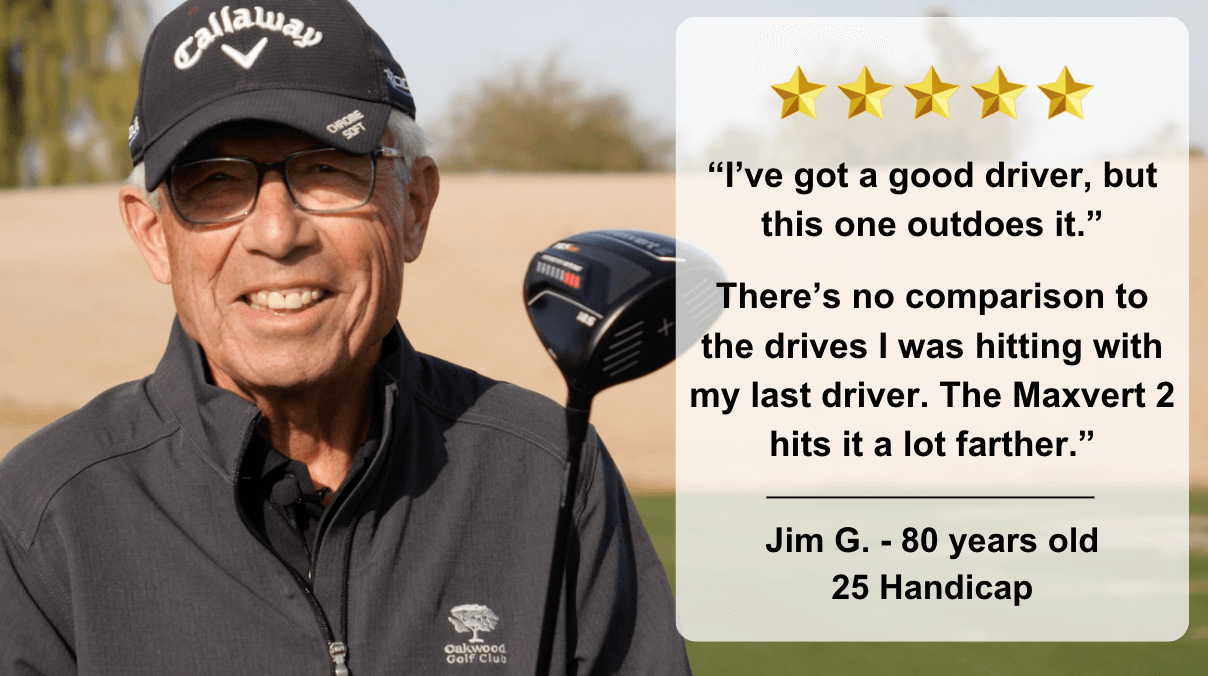
What’s Wrong With Traditional Drivers?
The Maxvert 2 is a collaboration between four-time Golf Digest Best-in-State Instructor Todd Kolb and award-winning club designer Josh Boggs. (More on them in a minute.)
As a PGA Instructor with over 30 years of experience coaching golfers of all levels, Kolb is deeply familiar with the differences between the needs of a tour player and those of a senior golfer (though, Kolb prefers the term “experienced golfer”).
He took this insight to Boggs, who added his own expertise in driver technology to pinpoint the biggest challenges everyday golfers face with traditional drivers.
Here’s a quick rundown:
The Shaft Placement is Killing Your Contact
You know your driver is the hardest club to control. You’ve got a bulky clubhead at the end of an ultra-long shaft. As Boggs has observed, even the pros struggle to keep the face closed with that construction.
What you may not have considered is the shaft placement. If you look your driver, you’ll see that the shaft enters the clubhead on the very edge of the heel.
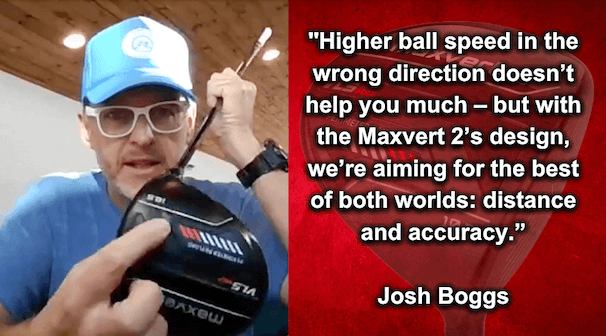
It’s as far as it can possibly be from the center of gravity. There’s no direct connection between your hands and the clubhead’s COG.
For a professional who can spend hours a day perfecting face control, this isn’t such a big deal. But for us regular folks, it’s almost a guaranteed mis-hit.
As Boggs puts it, “Higher ball speed in the wrong direction doesn’t help you much – but with the Maxvert 2’s design, we’re aiming for the best of both worlds: distance and accuracy, especially on off-center hits.”
Traditional Weight Distribution is a Missed Opportunity
It’s not just about where the center of gravity is. It’s also about how the weight is distributed in the clubhead.
The right weight distribution can do wonders to improve launch and offer more forgiveness on mis-hits.
But traditional drivers don’t take advantage of that opportunity because the best players in the world don’t need it.
The Flat Lie is Robbing You of Distance
Your current driver features a flat shaft angle that demands a flat backswing.
Now, this isn’t a problem for the young and flexible. But if your range of motion has diminished over the years, you won’t be able to rotate deeply enough to get decent length on a flat backswing.
The more senior-friendly method is a vertical swing, and traditional drivers simply aren’t built for that.
The Natural Positioning of the Club Subtly Wrecks Your Aim
Here’s something you probably never noticed:
Traditional drivers tend to sit a little open at address.
They might look square to your eye, but they are, in fact, deliberately designed to sit in a slightly open position. Tour players love that because, at their swing speed, it’s easier to control a cut.
Unfortunately, very few of us can match a tour player’s swing speed. And that means our aim is wrecked before we even initiate the takeaway.
So what’s the fix here?
The Designers’ Vision for the Maxvert 2
If you’re at all familiar with Todd Kolb, you know he’s become the “experienced” golfer’s biggest advocate.
He’s filled the gaps in traditional coaching with senior-focused instruction through one-on-one coaching, his in-person golf school, his bestselling book (The Bad Lie), and USGolfTV, a YouTube channel boasting over a quarter of a million subscribers.
Kolb is vocal about the importance of recognizing that what works for young, elite athletes won’t work for the everyday experienced golfer. So it’s no wonder he turned his attention to addressing the lack of senior-centered equipment.
He took his vision to Josh Boggs, a former designer for Nike and winner of several Golf Digest Hot List medals. Together, they designed the VLS Maxvert 1—the first driver developed exclusively around the senior golfer’s swing.
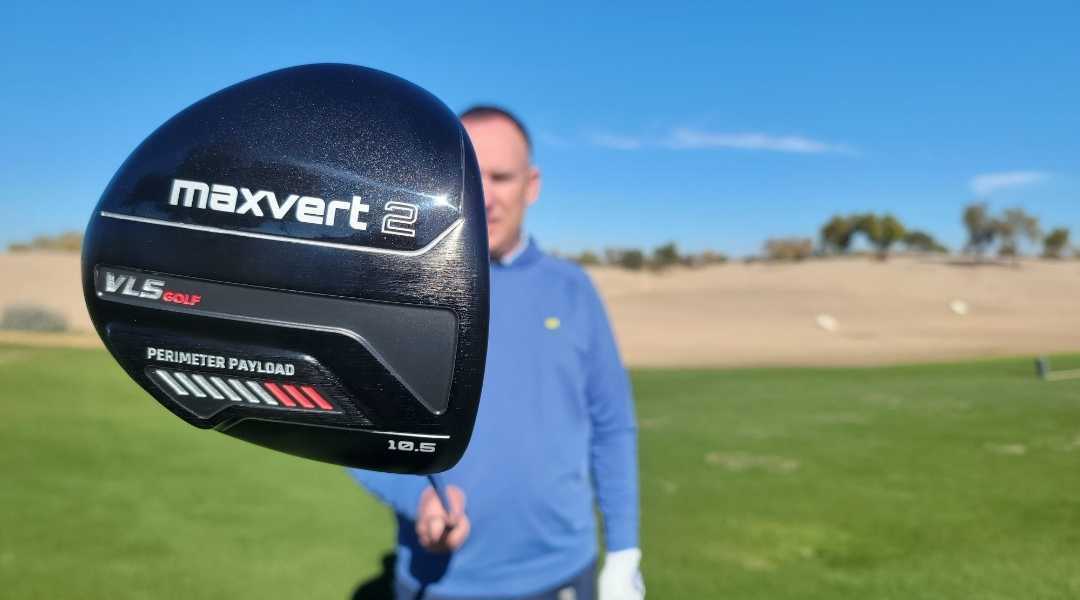
Two years later, there’s no denying that the Maxvert 1 has been a hit. Golfers of all ages and skill levels report picking up more yards and feeling more in control on the tee. But experienced golfers in particular are gobsmacked by the changes they’ve seen in their game.
Outdriving younger golfers. Hitting 17 greens in regulation. Sending it right down the middle every time without changing their swing.
Despite that success, Kolb and Boggs decided to push it further: even more distance, more launch, more control, and a more traditional look.
“The Maxvert 2 gives you the best of both worlds,” Kolb says. “It looks similar to other drivers, but its performance is completely different – it’s tailored to deliver what our golfers need to hit longer, straighter shots consistently.”
Maxvert 1 vs. Maxvert 2
So what’s changed between the original model and the newest generation?
Let’s take a look.
Stability-Enhanced Shaft Shift
Remember that issue with your current driver? The one where the hosel is set on the very edge of the heel, making it really hard to square the face at impact?
The Maxvert 1 drastically improved that situation with Shaft Shift Technology. Boggs moved the shaft axis closer to the center of head, creating a more direct line between your hands and the center of gravity.
Now, with the Maxvert 2, he’s made the hosel slightly larger, drawing the shaft even closer to the COG and giving the driver a more traditional look. As he explains it:
“The Stability-Enhanced Shaft Shift positions the hands closer to the clubface center, creating a stronger connection that promotes stability and control through impact. This setup means you can square the face more easily, which helps golfers get straighter, more consistent shots.”
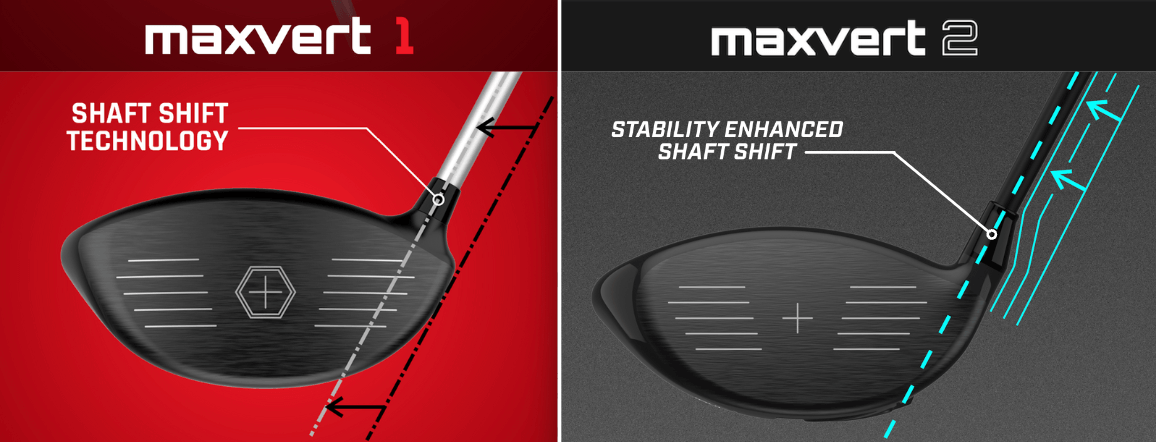
Upgraded Perimeter Payload
Golfers also loved the Perimeter Payload Weighting on the Maxvert 1. This innovation included extra weight on the outside of the heel, creating more stability, even on off-center shots.
While designing the Maxvert 2, Boggs discovered it was possible to push this concept further.
He moved the weight farther back in the heel for a higher moment of inertia. This means the head doesn’t twist as much when you miss the sweet spot.
The weight is also lower in the clubhead now—a choice that promotes higher launch, less spin, and a lot more distance.

“With weight moved lower and further back,” Boggs says, “this driver gives higher launch and more stability, which is perfect for maximizing performance, especially for golfers with slower swing speeds.”
Kolb adds that this feature is a lifesaver for golfers who tend to stand up their swing (a common habit as we get older).
Larger, Thinner Active Spring Face
The Maxvert 1 got a lot of glowing reviews for the way the ball springs off the clubface, even for golfers who don’t have the speed they used to have.
Now, the Maxvert 2 tests the limits of possibility with an ultra-thin (but still legal!) face. The face itself is also longer, making it easier to find the sweet spot and get the maximum springboard effect.

Standard Size Clubhead
The Maxvert 1 features a slightly smaller clubhead. This choice offered golfers more control; they didn’t have to battle it out with a monster clubhead.
But now, with all the enhanced stability features of the Maxvert 2, Boggs and Kolb were able to make the head larger. Golfers get the benefits of higher ball speed and smash factor without compromising the quality of their contact.
Other Key Features of the VLS Maxvert 2 Driver
So those are the Maxvert 2’s most notable improvements over the Maxvert 1. Let’s explore what else this driver has to offer.
Auto-Square Alignment
Remember how we said traditional drivers naturally sit slightly open at address?
The Maxvert 2 remedies this problem with a draw-biased design that naturally sits square to the target line.
Easier aim, no secret sabotage.
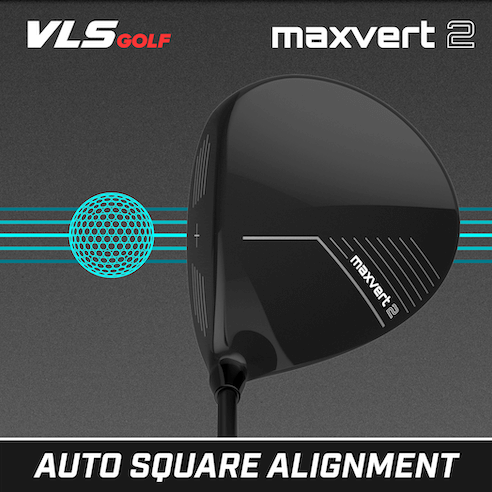
Adaptive Flex Graphite Shaft
This one is pretty cool. The Maxvert 2 features an Adaptive Flex graphite shaft that conforms to your swing speed.
You still have a choice of four flexes (stiff, regular, senior, and ladies). But whichever one you choose, you can still know that this shaft will adapt to your specific swing.
Playability Tuned Specs
As always, Boggs and Kolb considered the experienced golfer’s needs for every inch and angle of this driver. With your swing in mind, they chose:
- A more upright lie to promote a senior-friendly vertical swing
- 10.5° loft for easier launch
- 45” shaft—that’s what Kolb calls “proper standard length”
- 460 cc clubhead for more ball speed
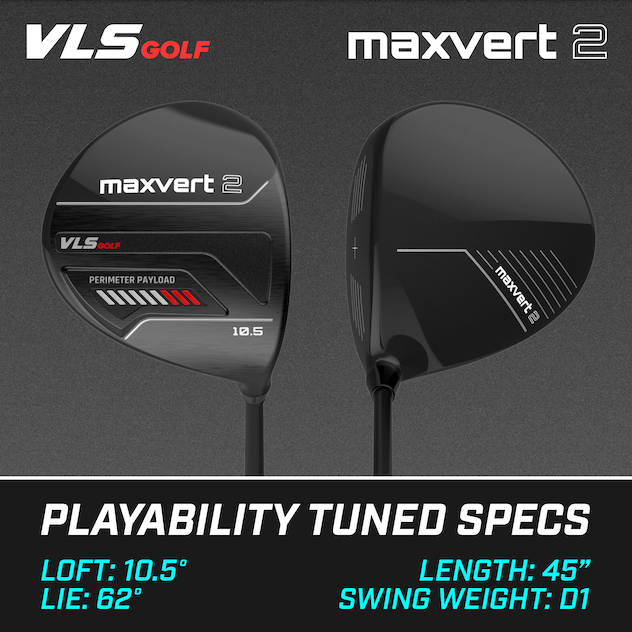
So that’s what you’d be buying if you got a Maxvert 2. But what does it cost?
Price and Guarantee
The VLS Maxvert 2 driver retails for $269.
If this club manages to do what it promises to do for you, that’s an exceptionally good price. Definitely less expensive than the big-name clubs.
It’s also the one driver experienced golfers don’t have to worry about customizing. It’s already designed for your swing with an Adaptive Flex shaft that conforms to your swing speed. Another significant cost savings.
As always, VLS Golf strives to eliminate the risk on your end with a 180-day money-back guarantee.
If you’ve never purchased from VLS Golf before, you might like to know they accept returns even when the club is scuffed or scratched. Kolb emphasizes that he wants golfers to have a chance to try the club as much as they need to without fear of voiding the guarantee.
Does the Maxvert 2 Driver Conform to the Rules of Golf?
With so many new adaptations all made in the golfer’s favor, it’s a fair question.
But yes, the Maxvert 2 is tournament legal.
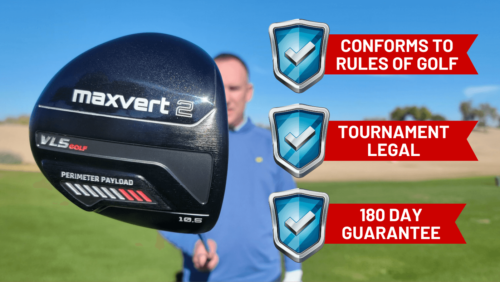
Is the Maxvert 2 Driver Worth It?
Now for the big question: Does the Maxvert 2 do what it promises?
We tested it ourselves and can confirm that this driver is legit.
We were already blown away by what the Mavert 1 could do when we tested it two years ago. We weren’t sure we’d be able to tell the difference with this new generation.
But there’s no doubt about it. It was even easier to launch the ball with the Maxvert 2—and we’re talking instantly better launch. We didn’t have to change our swing or put in a lot of practice time with this driver to get the results we were looking for.
We had no trouble picking up a few extra yards and sending it straight down the fairway consistently. Even our off-center shots stayed pretty close to the target.
As far as we’re concerned, this driver is a must-try for any amateur golfers, but especially golfers over 50. When you factor in the fuss-free 180-day guarantee, you’ve got virtually nothing to lose, and the potential gains are huge.
If you want to try it for yourself, you can get your Maxvert 2 driver here.
What Do You Think?
We’ve shared our two cents; now we want to hear yours.
What do you think of the new Maxvert 2? Do you think you’ll try it for yourself? Have you already tried it? What was your experience like?
Join the conversation in the comments below!
Interested in more senior-centric golf experiences? Check out VLSCoaching.com to learn how to work directly with Todd Kolb and the rest of the VLS Golf team.


I have a Maxvert 1. Do you have a trade in program?
thank you
We do not do trade-ins, but we do offer a discount for Maxvert 1 purchasers. Send an email to info@vlsgolf.com to get your discount. Thanks Mark!
Tried the original Maxvert 1 and sent it back for two reasons. 1. The hosel design made the looks of the club at address unappealing. 2. There was no difference in length from my current driver and dispersion on my current driver was more consistent (May have the look of the Maxvert at address). Might be interested in trying the Maxvert 2 version with the improvements in the club face and the looks.